Read the latest information on
Foot-and-mouth disease

In coming months around 200,000 beehives will be transported to and from almond growing regions in southern Australia for pollination, making effective biosecurity of bee hives more important than ever.
All commercial and hobby beekeepers are being urged to adopt the Australian Honey Bee Industry Biosecurity Code of Practice to keep their bees healthy and to safeguard honey bee and pollination dependent industries.
Honey production is worth more than $100 million annually, along with sales of beeswax, queen and packaged bees. This is dwarfed by the benefits of bee pollination services.
In coming months around 200,000 beehives will be transported to and from almond growing regions in southern Australia for pollination, making effective biosecurity of bee hives more important than ever.
“The aim of the National Bee Biosecurity Program and the associated Biosecurity Code of Practice is to ensure beekeepers have the awareness and knowledge to manage bee pests and diseases, and to detect exotic ones early,” said Australian Honey Bee Industry Council (AHBIC) Chair, Peter McDonald.
“Established pests and diseases like American foulbrood, small hive beetle and chalkbrood are causing significant economic and social harm to the bee industry and this would be exacerbated by an incursion of an exotic pest like the varroa mite,” he said.
 AHBIC worked with state governments, the Australian Government and Plant Health Australia to develop the National Bee Biosecurity Program and the Biosecurity Code of Practice. The honey bee industry contributes $400,000 per year to the program through levies.
AHBIC worked with state governments, the Australian Government and Plant Health Australia to develop the National Bee Biosecurity Program and the Biosecurity Code of Practice. The honey bee industry contributes $400,000 per year to the program through levies.
In some states, legislation has been changed to assist with adoption of the Biosecurity Code of Practice, and bee biosecurity officers and apiary officers are found in each state to assist beekeepers.
“This new management system has been put in place to limit the impact of pests and diseases on the businesses of individual beekeepers, but also the broader industry and economy,” said Plant Health Australia Executive Director and CEO, Greg Fraser.
The Australian Honey Bee Industry Biosecurity Code of Practice requires the nation’s 1500 commercial beekeepers, who have more than 50 hives each, and the 22,000 hobby beekeepers to use these best-practice biosecurity measures:
Commercial beekeepers also need to:
If you see anything unusual on bees in your area, call the hotline on 1800 084 881 and you’ll be put in touch with your local department of primary industries.
BeeAware website: www.beeaware.org.au is an important source of information for beekeepers, including the biosecurity code of practice, contact details for bee biosecurity officers, videos and online biosecurity training